We report a novel dual-lumophore oxygen sensor incorporating two lumophores: (1) the platinum(II) cyclometalated complex of the N^C^N-coordinating ligand 1,3,5-tri-(2-pyridyl)benzene and (2) Platinum octaethylporphyrin, which differ in both their emission colours and oxygen sensitivities. Sensor response is given by a dramatic change in emission colour, from red to green at different oxygen concentrations, due to the complete or partial luminescence quenching of one or both of the sensing elements. This approach enables the simple and rapid evaluation of the O2 concentration present, making it applicable to commercial technologies such as modified atmosphere packaging.





Similar content being viewed by others
REFERENCES
I. Bergman (1968). Rapid-response atmospheric oxygen monitor based on fluorescence quenching. Nature 218, 396.
E. R. Carraway, J. N. Demas, B. A. DeGraff, and J. R. Bacon (1991). Photophysics and photochemistry of oxygen sensors based on luminescent transition metal complexes. Anal. Chem. 63(4), 337–342.
H. N. McMurray, P. Douglas, C. Busa, and M. S. Garley (1994). Oxygen quenching of tris(2,2'-bipyridine) ruthenium(II) complexes in thin organic films. J. Photochem. Photobiol. A 80(1–3), 283–288.
J. N. Demas and B. A. DeGraff (1993). Luminescence-based sensors: Microheterogeneous and temperature effects. Sens. Actuators B 11(1–3), 35–41.
P. Douglas and K. Eaton (2002). Response characteristics of thin film oxygen sensors, Pt and Pd octaethylporphyrins in polymer films, Sens. Actuators B 82(1–3), 1–9.
K. Eaton, B. Douglas, and P. Douglas (2004). Luminescent oxygen sensors: Time-resolved studies and modelling of heterogeneous oxygen quenching of luminescence emission from Pt and Pd octaethylporphyrin in thin polymer films. Sens. Actuators B 97(1), 2–12.
Y. Amao, Y. Tabuchi, Y. Yamshita, and K. Kimura (2002). Novel optical oxygen sensing material: Metalloporphyrin dispersed in fluorinated poly(aryl ether ketone) films. Eur. Polym. J. 38(4), 675–681.
R. N. Gillanders, M. C. Tedford, P. J. Crilly, and R. T. Bailey (2004). Thin film dissolved oxygen sensor based on platinum octaethylporphyrin encapsulated in an elastic fluorinated polymer. Anal. Chim. Acta 502(1), 1–6.
P. Douglas and K. Eaton (2002). On the inappropriate use of gated emission measurements in oxygen quenching studies of luminescent thin film sensors. Sens. Actuators B 82(1), 48–53.
K. Eaton (2002). A novel colorimetric oxygen sensor: Dye redox chemistry in a thin polymer film. Sens. Actuators B 85(1–2), 42–51.
J. Kavandi, J. Callis, M. Gouterman, G. Khalil, D. Wright, E. Green, D. Burns, and B. McLachlan (1990). Luminescent barometry in wind tunnels. Rev. Sci. Instrum. 61, 3340–3347.
F. Baldini, M. Bacci, F. Cosi, and A. D. Bianco (1992). Absorption based optical fibre oxygen sensor. Sens. Actuators B 7(1–3), 752–757.
D. B. Papkovsky (1995). New oxygen sensors and their application to biosensing. Sens. Actuators B 29(1–3), 213–218.
M. F. Choi and P. Hawkins (1996). A fibre-optic oxygen sensor based on contact charge-transfer absorption. Sens. Actuators B 30(3), 167–171.
M. Smolander, E. Hurne, and R. Ahvenainen (1997). Leak indicators for modified-atmosphere packages. Trends Food Sci. 8(4), 101–105.
Y. Yoshikawa, T. Nawata, M. Goto, and Y. Kondo (1982). Oxygen indicator adapted for printing or coating and oxygen-indicating device. US 4,349,509.
Y. Yoshikawa, T. Nawata, M. Goto, and Y. Fujii (1979). Oxygen indicator. US 4,169,811.
K. C. Krumhar and M. Karel (1992). Visual Indicator System. US 50,096,813.
R. Ahvenainen, M. Eilamo, and E. Hurne (1997) .Detection of improper sealing and quality deterioration of modified-atmosphere-packaged pizza by a colour indicator. Food Control 8(4), 177–184.
M. Smiddy, M. Fitzgerald, J. P. Kerry, D. B. Papkovsky, C. K. O'Sullivan, and G. G. Guilbault (2002). Use of oxygen sensors to non-destructively measure the oxygen content in modified atmosphere and vacuum packed beef: Impact of oxygen content on lipid oxidation. Meat Sci. 61(3), 285–290.
M. Smiddy, N. Papkovskaia, D. B. Papkovsky, and J. P. Kerry (2002). Use of oxygen sensors for the non-destructive measurement of oxygen content in modified atmosphere and vacuum packs of cooked chicken patties: Impact of oxygen content on lipid oxidation. Food Res. Int. 35(6), 577–584.
T. C. O'Riordan, H. Voraberger, J. P. Kerry, and D. B. Papkovsky (2005). Study of migration of active components of phosphorescent oxygen sensors for food packaging applications. Anal. Chim. Acta 530(1), 135–141.
S. J. Farley, D. L. Rochester, A. L. Thompson, J. A. K. Howard, and J. A. G. Williams (2005). Controlling emission energy, self-quenching and excimer formation in highly luminescent N^C^N coordinated platinum(II) complexes, Inorg. Chem. In press.
K. Kalyanasundaram (1992). Photochemistry of Polypyridine and Porphyrin Complexes, Academic Press, New York, p. 500.
Y. Le Grand (1957). Light, Colour and Vision, Chapman and Hall, London.
D. B. Judd and G. Wyszecki (1962). Color in Business, Science and Industry, Wiley, New York.
J. A. G. Williams, A. Beeby, E. S. Davies, J. A. Weinstein, and C. Wilson (2003). An alternative route to highly luminescent platinum(II) complexes: Cyclometalation with N^C^N-coordinating dipyridylbenzene ligands. Inorg. Chem. 42(26), 8609–8611.
C. A. Phillips (1996). Modified Atmosphere Packaging and its effects on the microbiological quality and safety of produce. Int. J. Food Sci. Tech. 31(6), 463–479.
ACKNOWLEDGMENTS
RCE would like to acknowledge the University of Wales Swansea for a Research Scholarship, and DLR the EPSRC and the University of Durham for a DTA studentship.
Author information
Authors and Affiliations
Corresponding author
Rights and permissions
About this article
Cite this article
Evans, R.C., Douglas, P., Williams, J.A.G. et al. A Novel Luminescence-Based Colorimetric Oxygen Sensor with a “Traffic Light” Response. J Fluoresc 16, 201–206 (2006). https://doi.org/10.1007/s10895-005-0037-9
Received:
Accepted:
Published:
Issue Date:
DOI: https://doi.org/10.1007/s10895-005-0037-9




